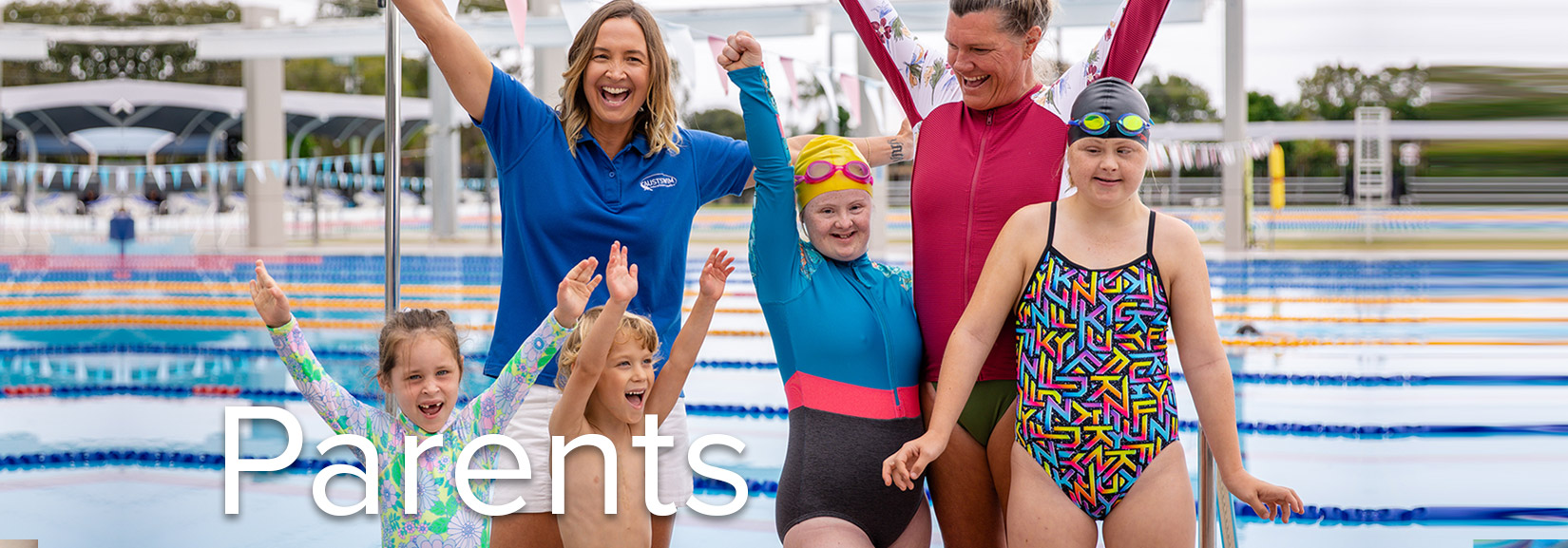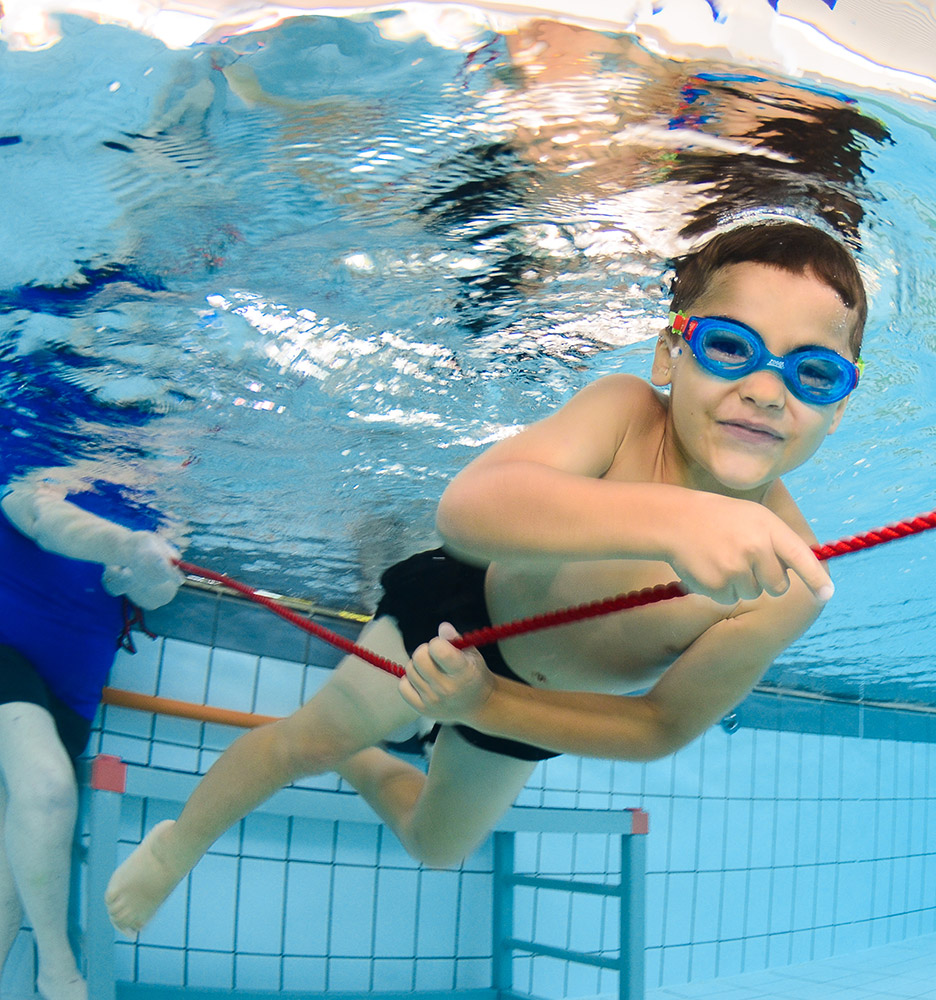Login to the E-Learning Centre:
Not an AUSTSWIM student yet?
Learn more about our online swim training here
Not an AUSTSWIM student yet?
Learn more about our online swim training here

Enter a Suburb or Postcode.

Enter a Suburb or Postcode.


|
Classification |
Age (Months) |
Performance Indicator |
Maximum Ratio |
|
Baby |
0 - 6 |
Sensory exploration |
With parent(s) at home |
|
Infant |
6 - 12 |
Water familiarisation and initial independence |
1:8 teacher/parent-child pairs |
|
Toddler 1 |
12 - 24 |
Water familiarisation and Initial independence |
1:8 teacher/parent-child pairs |
|
Toddler 2 |
24 - 36 |
Water familiarisation and basic skill development |
1:8 teacher/parent-child pairs |
|
Pre-schooler 1 |
36 - 42 |
Water familiarisation and basic skill development |
1:5 teacher - children |
|
Pre-schooler 2 |
42 - 60 |
Confidence and basic aquatic skill development |
1:5 teacher - children |


Brooke Hanson, AUSTSWIM Ambassador and Australian Olympic gold medallist, world champion, and former world record-holder.


It is important to make sure that your swim centre is AUSTSWIM Recognised before committing your child to the programme. You should also take the following into consideration:
AUSTSWIM Schools of Excellence educate students using a range of activities including: water familiarisation, social interaction, water safety education, skill acquisition and parent involvement/ education. The number of children in a lesson varies depending on the age and competency of students, plus the venue being utilised.
The programs offered at AUSTSWIM Schools of Excellence will vary. They will likely include:
Swim centres have different programs for students and will offer group or private lessons depending on the size of the centre, teacher availability and equipment required for your child. The water is an equalising environment where people of all abilities can learn balance, stability and spatial awareness. Students will also learn life-saving skills and develop their fine and gross motor skills, including muscle strength, coordination and range of movement.
It is important to ensure that your chosen swim centre is AUSTSWIM recognised and the teacher has completed the AUSTSWIM Teacher of Aquatics – Access and Inclusion (TAI) course. It is important that the teacher listens to you and your child and is supportive of your child’s goals.
Swim centres have different programs for students and will offer group or private lessons depending on the size of the centre, teacher availability and equipment required. Where possible, the goal is to be able to provide students with experiences and learning in mainstream classes.
Children flourish under the caring supervision of an accredited AUSTSWIM Teacher who will address their unique needs. The teacher will help them explore a new environment and develop new movement patterns and abilities.
AUSTSWIM recommends that infants and children start their aquatic programs after the age of six months. AUSTSWIM does not recommend formal aquatic education programs for infants under the age of 6 months, based on information from medical and child development experts.
Students will feel a myriad of emotions ahead of their first swimming and water safety lesson. To make the transition smoother:
Students require understanding and support to learn and progress at their own pace.
Learning aquatic knowledge and skill occurs over an undetermined period of time and requires ongoing and consistent participation from the students and teachers.
AUSTSWIM Teachers give children the opportunity to enjoy the aquatic learning experience in a positive and educational environment. AUSTSWIM recommends that one short, 30-minute lesson be attended each week to create the best learning experience.
What is the standard my child should reach?
Learning is a continuous personal process that is individual to the person, with skills evolving over a period of time. Learning requires ongoing and consistent participation from students to become competent at a range of skills and gain understanding of how to stay safer in, on and around water.
Should my child wear flotation devices in swimming and water safety lessons?
Flotation aids may assist with gaining confidence, independence and skill. However, any activity undertaken with flotation aids must also be attempted without. The use of aids stops the students from understanding how their body moves, reacts and responds in, on and around water.
How often should my child attend swimming and water safety lessons?
AUSTSWIM Teachers give children the opportunity to enjoy the aquatic learning experience in a positive and educational environment. AUSTSWIM recommends that one short, 30-minute lesson be attended each week to ensure the best learning experience. You should also stimulate water familiarisation and water confidence by playing safely with active supervision at aquatic venues and environments outside their child’s swimming and water safety lesson.
How long does my child need to attend swimming and water safety lessons?
The amount of time it takes for a child to acquire the most important water safety skills will depend on the person. It is important to note that despite swimming and water safety lessons, no child is ever drown-proof; always supervise your children carefully.
The process of learning to swim depends on many factors. As the Australian way of life is recreational based, some students develop a passion for the sport and continue to swim competitively, whilst others will stop before they reach this stage. When a student stops swimming too early, they no longer practice the fundamental skills of swimming. This will mean the skills are forgotten and lost over time.
Children continue to enjoy many years of aquatic fun after they have completed their swimming and water safety lessons. At a very minimum, parents should ensure their children attend swimming and water safety lessons until they:
The following information is a guideline on the amount of time it can take children to learn to swim independently and to learn to save themselves from drowning. In group lessons, the process of learning to swim is slower. This guideline assumes children attend 30-minute private swim lessons weekly, year round:
The best age for your child to begin the process of learning to swim is as close to six months as possible. The sooner your child begins to learn to swim, the sooner they will learn to be safer in, on and around water.
The most important factors that come into play when learning to swim include:
Consistency
Once kids begin the process of learning to swim, consistency is key. It is important to keep the lessons/water visits consistent and avoid taking long breaks from swimming until the child can swim independently. A consistent swimming schedule allows for muscle memory to form and keeps the progress going. Taking breaks from swimming (e.g. during the winter months) will set back the learning process, as the child will have to reacclimate with the water or relearn previously learned skills upon resuming swimming.
Frequency
Most parents opt for their children to undertake swimming and water safety lessons once a week. In this case, it’s important to keep the lessons consistent. Swimming twice a week or more allows for great progress and helps children learn faster. Additionally, practicing with your child is a great way to help them learn faster and increase their confidence in, on and around water.
Fear of water
Children who are introduced to the water at an early age and in a positive manner are more likely to develop a love for the water and not be afraid – which will help them learn to swim faster. If a child is afraid of water, it may take longer to learn to swim. Parents can take an active role in helping children alleviate their fear by taking them to the water whenever possible. Once the little swimmer is relaxed and happy in, on and around water, learning skills such as submerging the face or the back float will come easier.
Motor skills and natural abilities
Physical abilities, coordination and motor skills all play a role in how quickly a child will learn to swim. Learning to swim comes easier to children with good natural abilities. Children who have motor skills difficulties may take longer to learn, so the parent and instructor should be patient and work at the child’s pace. For those children, swimming and water safety lessons also help them to improve their motor skills and coordination.
Private swimming versus group swimming lessons
The dynamic between private swimming lessons and group swimming lessons is different. Children enrolled in private lessons will learn to swim faster, as all the attention is focused on the child. The teacher can individualise the class to the child’s needs and can concentrate on the areas that need most attention.
The downside of group lessons for non-swimmers is that children spend most of the lesson waiting for their turn and they don’t receive as much one-on-one attention or actual swimming time. One positive aspect of group lessons for beginners is that some children can get motivated to learn by watching and playing with their peers in, on and around water.
It is important to continue swimming lessons until the student has mastered the skills that could save their lives. At a very minimum, parents should ensure their children attend swimming and water safety lessons until they:
The following information relates to the detrimental impact of abandoning swimming and water safety lessons:
There are many positive impacts that result from continuing with swimming and water safety lessons for children. Swimming is one of the few public health interventions that is low cost with a high return on investment. It is more than a sport and physical pursuit – it is a life-saving intervention. Children who have regular weekly lessons are more likely to reach national safety and swimming benchmarks around 9-10 years of age.
Staying the course is vital to provide your child with the skills they need to have a safer experience in, on or around water.

SWIMMING AND WATER SAFETY STARTS WITH US.
